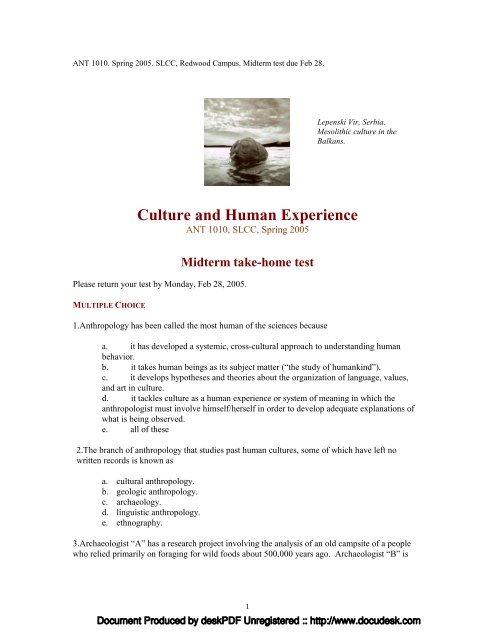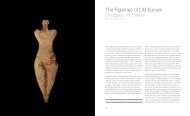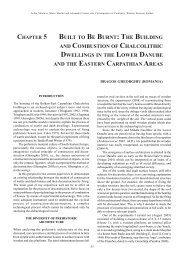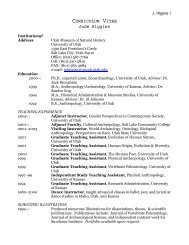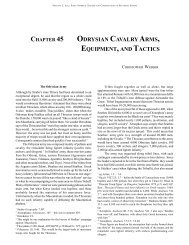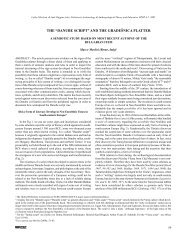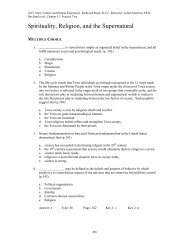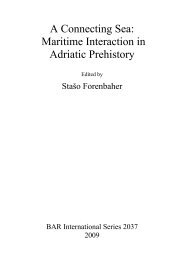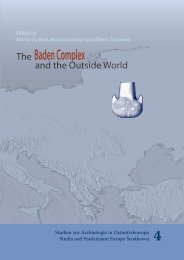Midterm take-home test - International Institute of Anthropology
Midterm take-home test - International Institute of Anthropology
Midterm take-home test - International Institute of Anthropology
Create successful ePaper yourself
Turn your PDF publications into a flip-book with our unique Google optimized e-Paper software.
ANT 1010. Spring 2005. SLCC, Redwood Campus. <strong>Midterm</strong> <strong>test</strong> due Feb 28.<br />
Lepenski Vir, Serbia.<br />
Mesolithic culture in the<br />
Balkans.<br />
Culture and Human Experience<br />
ANT 1010, SLCC, Spring 2005<br />
Please return your <strong>test</strong> by Monday, Feb 28, 2005.<br />
<strong>Midterm</strong> <strong>take</strong>-<strong>home</strong> <strong>test</strong><br />
MULTIPLE CHOICE<br />
1.<strong>Anthropology</strong> has been called the most human <strong>of</strong> the sciences because<br />
a. it has developed a systemic, cross-cultural approach to understanding human<br />
behavior.<br />
b. it <strong>take</strong>s human beings as its subject matter (“the study <strong>of</strong> humankind”).<br />
c. it develops hypotheses and theories about the organization <strong>of</strong> language, values,<br />
and art in culture.<br />
d. it tackles culture as a human experience or system <strong>of</strong> meaning in which the<br />
anthropologist must involve himself/herself in order to develop adequate explanations <strong>of</strong><br />
what is being observed.<br />
e. all <strong>of</strong> these<br />
2.The branch <strong>of</strong> anthropology that studies past human cultures, some <strong>of</strong> which have left no<br />
written records is known as<br />
a. cultural anthropology.<br />
b. geologic anthropology.<br />
c. archaeology.<br />
d. linguistic anthropology.<br />
e. ethnography.<br />
3.Archaeologist “A” has a research project involving the analysis <strong>of</strong> an old campsite <strong>of</strong> a people<br />
who relied primarily on foraging for wild foods about 500,000 years ago. Archaeologist “B” is
studying a medieval Danish village and comparing evidence <strong>of</strong> how the common people lived with<br />
historical records that were written primarily from the point <strong>of</strong> view <strong>of</strong> wealthy merchants and<br />
royalty. Archaeologist “A” is studying _____________.<br />
a. Arctic<br />
b. prehistoric<br />
c. future<br />
d. historical<br />
e. culture-bound<br />
4.Archaeologists studying the Classic period <strong>of</strong> Mayan civilization before about 1960 made<br />
culture-bond assumptions that the Classic Maya<br />
a. were more developed than present population in their forms <strong>of</strong> agriculture.<br />
b. were food foragers.<br />
c. practiced the same slash-and-burn cultivation that people do today, and therefore<br />
could not have lived in large permanent settlements.<br />
d. lived in large, permanent settlements based on slash-and-burn cultivation.<br />
e. were industrialists with space-age technology.<br />
5.Cross-cultural research that allows the anthropologist to develop theories that help explain why<br />
certain important differences or similarities occur between groups is known as<br />
a. ethnography.<br />
b. biography.<br />
c. ethnology.<br />
d. ethnohistory.<br />
e. ethnoarchaeology.<br />
6. In-depth descriptive studies <strong>of</strong> specific cultures are called<br />
a. ethnologies.<br />
b. ethnobotanies.<br />
c. biologies.<br />
d. ethnographies.<br />
e. anthropologies.<br />
7. Doing fieldwork in a particular culture means that ethnographers<br />
a. stay in their country <strong>of</strong> origin and interview immigrants from the country they wish to<br />
study.<br />
b. go to the country and live life as if they were natives.<br />
c. live in the country but try to maintain a balance between participation and observation.<br />
d. all <strong>of</strong> these<br />
e. none <strong>of</strong> these<br />
8. Using the traditional ethnographic method, an anthropologist working in rural Peru found that<br />
people<br />
2
a. frequently worked together on each others’ land.<br />
b. never worked together on each others’ land.<br />
c. said they frequently worked together on each others’ land, but actually did so rarely.<br />
d. said they never worked together on each others’ land, but actually did so frequently.<br />
e. refused to answer the sociologist’s questionnaire, but responded to the more informal<br />
tactics <strong>of</strong> the anthropologist.<br />
9. The anthropologists who focus on humans as biological organisms, tracing their evolutionary<br />
development and looking at biological variations within the species, past and present are<br />
known as<br />
a. archaeologists.<br />
b. linguistic anthropologists.<br />
c. biologists.<br />
d. physical anthropologists.<br />
e. forensic anthropologists.<br />
10. Which <strong>of</strong> the following is not one <strong>of</strong> the four branches <strong>of</strong> anthropology?<br />
a. archaeology<br />
b. linguistics<br />
c. biology<br />
d. ethnology<br />
e. physical anthropology<br />
11. Cultural anthropology is the systematic study <strong>of</strong> the standards by which societies operate.<br />
These standards<br />
a. are biologically inherited.<br />
b. operate only when people are unconscious.<br />
c. can be studies only by sociologists.<br />
d. are learned and constitute “culture.”<br />
e. are inherited and are studied by physical anthropologists.<br />
12. A “culture-bound” theory is<br />
a. a prediction that is bound to be fulfilled in a particular culture.<br />
b. a theory developed by a cultural anthropologist rather than a physical anthropologist.<br />
c. a theory developed by a sociologist rather than a cultural anthropologist.<br />
d. a theory based on assumptions common to a particular culture rather than deriving<br />
from comparisons <strong>of</strong> many different cultures.<br />
e. a theory based on comparison <strong>of</strong> cultures.<br />
13. Historians, who usually study the past through written sources, are limited chronologically to<br />
a. the past 500 years.<br />
b. the past 1,000 years.<br />
c. the past 5,000 years.<br />
d. the past 10,000 years.<br />
3
e. the past 500,000 years.<br />
14.The branch <strong>of</strong> cultural anthropology that studies human languages is called<br />
a. linguistic anthropology.<br />
b. ethnology.<br />
c. ethnography.<br />
d. ethnolinguistics.<br />
e. ethnography <strong>of</strong> speaking.<br />
15. Which <strong>of</strong> the following research projects would NOT belong to the province <strong>of</strong> linguistic<br />
anthropology?<br />
a. Learning about a culture by finding out which objects or events are associated with a<br />
large vocabulary.<br />
b. Reconstructing the evolution <strong>of</strong> the big toe to find out at what time humans began to<br />
walk upright.<br />
c. Comparing languages to see which ones can be traced back to a single unifying<br />
language.<br />
d. Describing how, in a particular language, sounds are combined to form words, and<br />
how words are combined to form sentences.<br />
e. all <strong>of</strong> these (that is, a linguistic anthropologist would not be interested in any <strong>of</strong> the<br />
above research projects)<br />
16. Which <strong>of</strong> the following is not goal <strong>of</strong> science?<br />
a. to discover the universal principles that govern the workings <strong>of</strong> the visible world.<br />
b. to develop explanations <strong>of</strong> the world that are <strong>test</strong>able and correctable.<br />
c. to eliminate the need to use the imagination.<br />
d. all <strong>of</strong> these are goals <strong>of</strong> science.<br />
e. only a and b<br />
17. Which <strong>of</strong> the following exemplifies the concept <strong>of</strong> a “hypothesis”? The light bulb failed<br />
to light because<br />
a. the filament was broken.<br />
b. the power to the building was <strong>of</strong>f.<br />
c. it was not screwed in tightly.<br />
d. it was poorly made.<br />
e. all <strong>of</strong> these<br />
18. A(n) _______________ is a closely examined and critically checked out explanation <strong>of</strong><br />
observed reality.<br />
a. attractive hunch<br />
b. dogma<br />
c. doctrine<br />
d. indisputable opinion<br />
e. theory<br />
4
19. Anthropologists doing fieldwork typically involve themselves in many different<br />
experiences. They try to investigate not just one aspect <strong>of</strong> culture (such as the political<br />
system) but how all aspects relate to each other (for example, how the political system fits<br />
with economic institutions, religious beliefs, etc.). This approach is called the<br />
_______________ perspective.<br />
a. holistic<br />
b. ethnological<br />
c. sociocultural<br />
d. sociological<br />
e. culture-bound<br />
20. Questionnaire surveys<br />
a. enable anthropologists to discover unexpected patterns <strong>of</strong> behavior.<br />
b. are never used by anthropologists.<br />
c. are used by anthropologists to supplement information gained by some other means.<br />
d. are used only by sociologists.<br />
e. get at real (vs. ideal) patterns <strong>of</strong> behavior.<br />
21. What kind <strong>of</strong> information do questionnaires usually tap?<br />
a. factual rather than intuitive reality<br />
b. what people think about reality, which is not necessarily what they do<br />
c. the preconceived expectations <strong>of</strong> outsiders rather than reality as experienced by those<br />
who are being studied<br />
d. all <strong>of</strong> these<br />
e. b and c<br />
22. In what way does anthropology provide basic skills for survival in the modern world?<br />
a. It teaches us how to hunt game if we are ever lost in the wilderness.<br />
b. It makes us less provincial.<br />
c. It enables us to see that we are part <strong>of</strong> a global community rather than the center <strong>of</strong> the<br />
universe.<br />
d. It gives us a greater sensitivity to cultural differences.<br />
e. all <strong>of</strong> these except a<br />
23. The term that refers to worldwide interconnectedness, signified by global movements <strong>of</strong><br />
natural resources, trade goods, human labor, finance capital, information, and infectious<br />
diseases is known as<br />
a. nationalization.<br />
b. internationalization.<br />
c. pandemonium.<br />
d. globalization.<br />
e. holism.<br />
5
24. Which <strong>of</strong> the following characteristics distinguishes primates from other mammals?<br />
a. a large complex brain in which the area devoted to smell is quite large<br />
b. the development <strong>of</strong> more teeth <strong>of</strong> a highly specialized nature<br />
c. increased visual acuity because <strong>of</strong> stereoscopic and color vision<br />
d. the development <strong>of</strong> a specific breeding season and increased number <strong>of</strong> <strong>of</strong>fspring<br />
e. All <strong>of</strong> the above<br />
25. The transition to bipedalism probably occurred in a context where primates spent<br />
a lot <strong>of</strong> time in the trees but ventured out periodically onto the open savanna to exploit the food<br />
resources there. This transition occurred because bipedalism conferred the advantage <strong>of</strong><br />
a. being able to climb trees more effectively.<br />
b. being able to run faster on the ground.<br />
c. freeing hands for a variety <strong>of</strong> purposes..<br />
d. being able to scan for danger more effectively.<br />
e. All <strong>of</strong> the above.<br />
26. The earliest known tool tradition<br />
a. is called Oldowan.<br />
b. begins about 2.5 million years ago.<br />
c. marks the beginning <strong>of</strong> the Paleolithic.<br />
d. All <strong>of</strong> the above<br />
e. None <strong>of</strong> the above<br />
27. These people were the first to develop an extensive art and decorative tradition<br />
a. Homo habilis<br />
b. Homo erectus<br />
c. Neanderthal<br />
d. Upper Paleolithic<br />
e. fully modern Homo sapiens<br />
28. The primates most closely related to humans are the<br />
a. baboons and macaques.<br />
b. chimpanzees and bonobos.<br />
c. lorises and lemurs.<br />
d. orang-utan and tarsiers.<br />
e. none <strong>of</strong> the above.<br />
29. The area <strong>of</strong> the brain which enlarged dramatically in primates is the<br />
a. cerebellum.<br />
b. cerebral hemispheres.<br />
c. medulla.<br />
d. notochord.<br />
6
e. All <strong>of</strong> the above<br />
30. Remains found in southern Africa suggest that _______________ may have learned to use<br />
fire by 1 million years ago.<br />
a. A. afarensis<br />
b. H. sapiens<br />
c. H. habilis<br />
d. Ardipithecus ramidus<br />
e. H. erectus<br />
31. The “out <strong>of</strong> Africa” hypothesis refers to<br />
a. the molecular evidence that all modern humans derive from a common African<br />
ancestor.<br />
b. the belief that humans did not evolve, but were created by God.<br />
c. the fossil evidence that Neanderthal was wiped out by modern humans.<br />
d. the primate evidence suggesting that humans are descended from modern chimpanzees.<br />
e. none <strong>of</strong> the above.<br />
32. Present evidence suggests that humans evolved from small, African apes between<br />
________ and ________ million years ago.<br />
a. 10/15<br />
b. 1/4<br />
c. 12/20<br />
d. 8/5<br />
e. 50/100<br />
33. Chimps are capable <strong>of</strong> which <strong>of</strong> the following behaviors?<br />
a. pick up and prepare objects in anticipation <strong>of</strong> future use at some other location.<br />
b. communicate at the level <strong>of</strong> 8 year old human.<br />
c. read at the level <strong>of</strong> a human 5 year old.<br />
d. use objects as tools to solve problems.<br />
e. a and d.<br />
34. Humans are unique in their biological capacity to produce a rich array <strong>of</strong><br />
_______________ to the environment.<br />
a. cultural adaptations.<br />
a. physiological adaptations.<br />
b. natural selection.<br />
c. environmental accommodations.<br />
35. All _______________, as systems <strong>of</strong> communication using sounds that are put together in<br />
meaningful ways according to a set <strong>of</strong> rules, are organized on the same basic plan<br />
a. languages<br />
7
. symbols<br />
c. signals<br />
d. phonetics<br />
e. core vocabulary<br />
36. In Pavlov’s classical study <strong>of</strong> conditioning, a dog that salivated to the taste <strong>of</strong> meat was<br />
taught to salivate to the sound <strong>of</strong> a bell by having the two stimuli paired. After this<br />
training, the ringing <strong>of</strong> a bell constituted a _______________ for the dog because the<br />
meaning, “meat,” was implicit in the immediate experience <strong>of</strong> bell ringing; for the dog<br />
it had a natural or self-evident meaning.<br />
a. symbol<br />
b. signal<br />
c. language<br />
d. grammar<br />
e. Paralanguage<br />
37. Which <strong>of</strong> the following statements about signals and symbols is INCORRECT?<br />
a. Both signals and symbols are forms <strong>of</strong> communication.<br />
b. Both signals and symbols can be learned.<br />
c. Signals are in response to aspects <strong>of</strong> the immediate environment such as Pavlov’s dog<br />
salivating at the sound <strong>of</strong> a bell or a human’s eye dilating at the sight <strong>of</strong> something<br />
pleasurable.<br />
d. Symbols are arbitrary and can be used independent <strong>of</strong> a particular environment, such<br />
as the word “Roman” when no Rome or Romans are present, or “holy water” when a ritual<br />
ceremony has been performed over river water.<br />
e. All <strong>of</strong> the above are correct.<br />
38. The modern scientific study <strong>of</strong> all aspects <strong>of</strong> language is<br />
a. kinetics.<br />
b. phonology.<br />
c. linguistics.<br />
d. grammar.<br />
e. glottochronology.<br />
39. The systemic study <strong>of</strong> the production, transmission, and reception <strong>of</strong> speech sounds is<br />
a. linguistics.<br />
b. morphology.<br />
c. frame substitution.<br />
d. phonetics.<br />
e. syntax.<br />
40. The study <strong>of</strong> abstract rules that guide the sound patterns <strong>of</strong> a language is called<br />
a. phonetics.<br />
b. phonology.<br />
8
c. syntax.<br />
d. morphology.<br />
e. frame substitution.<br />
41. The smallest class <strong>of</strong> sound that makes a difference in meaning is a(n)<br />
a. allophone.<br />
b. morpheme.<br />
c. allomorph.<br />
d. phoneme.<br />
e. free morpheme.<br />
42. Consider the English word “dog.” Which <strong>of</strong> the following is a morpheme?<br />
a. “d”<br />
b. “dog”<br />
c. “o”<br />
d. “g”<br />
e. All <strong>of</strong> the above<br />
43. The method called frame substitution enables the linguist to establish the rules or<br />
principles by which language users construct phrases and sentences, i.e., the<br />
_______________ <strong>of</strong> the language.<br />
a. morphology<br />
b. form classes<br />
c. core vocabulary<br />
d. sociolinguistics<br />
e. syntax<br />
44. The entire formal structure <strong>of</strong> a language consisting <strong>of</strong> all observations about its<br />
meaningful units <strong>of</strong> sounds and the rules or principles <strong>of</strong> making phrases and sentences is<br />
called its<br />
a. syntax.<br />
b. form classes.<br />
c. morphology.<br />
d. phonology.<br />
e. grammar.<br />
45. Which <strong>of</strong> the following statements about kinesics is CORRECT?<br />
a. Kinesics refers to the system <strong>of</strong> extralinguistic noises that accompany spoken<br />
language.<br />
b. Kinesics research has demonstrated that gender signals communicated through posture<br />
are biologically based rather than learned.<br />
c. Cross-cultural research indicates that the body language used when people are<br />
greeting each other is similar all over the world.<br />
d. All cultures have the same gestures for “yes” and “no.”<br />
9
e. All <strong>of</strong> the above are correct.<br />
46. Paralanguage is to speech as _______________ is to position <strong>of</strong> the body.<br />
a. kinesics<br />
b. ethnolinguistics<br />
c. form class<br />
d. phonetics<br />
e. displacement<br />
47. Two people say to you, “You sure look nice today.” Although they are saying the same<br />
words, you can tell that one person is being complimentary and the other sarcastic by their<br />
__________________<br />
a. vocalizations.<br />
b. vocal characteristics.<br />
c. voice qualities.<br />
d. voice segregates.<br />
e. vocal qualifiers.<br />
48. _______________ linguistics is concerned with the study <strong>of</strong> relationships between earlier<br />
and later forms <strong>of</strong> a language, antecedents (in older languages) <strong>of</strong> developments in modern<br />
languages, and relationships among older languages.<br />
a. Extrab.<br />
Descriptive<br />
c. Sociod.<br />
Historical<br />
e. Para-<br />
49. In contrast with historical linguistics, descriptive linguistics<br />
a. attempts to explain the features <strong>of</strong> a particular language at one time in its history.<br />
b. looks at languages as separate systems without considering how they might be related<br />
to each other.<br />
c. attempts to construct a language’s historical development.<br />
d. investigates relationships between earlier and later forms <strong>of</strong> the same language.<br />
e. a and b only<br />
50. A language family is a group <strong>of</strong> languages<br />
a. that all have the same core vocabulary.<br />
b. that are subordinate to a dominant language.<br />
c. that all have the same syntax.<br />
d. that use the same number <strong>of</strong> sounds.<br />
e. that are descended from a single ancestral language.<br />
51. Which <strong>of</strong> the following statements about the English language is CORRECT?<br />
a. English belongs to the Indo-European language family.<br />
10
. English belongs to the Germanic language subgroup.<br />
c. English is one <strong>of</strong> the many languages which diverged from an ancient unified<br />
language called Proto-Indo-European.<br />
d. None <strong>of</strong> the above are correct.<br />
e. All <strong>of</strong> the above are correct.<br />
52. The development <strong>of</strong> different languages from a single ancestral language is called<br />
a. descriptive linguistics.<br />
b. historical linguistics.<br />
c. language subgroups.<br />
d. linguistic divergence.<br />
e. linguistic nationalism.<br />
53. If the core vocabulary <strong>of</strong> two languages is compared by glottochronologists, it is thought<br />
possible to determine<br />
a. if the two languages perceive reality in the same way.<br />
b. if the two languages use the same syntax.<br />
c. if they share the same allophones.<br />
d. if they have a similar technology<br />
e. how long ago the languages separated from each other.<br />
54. Although language may be studied as an independent system, it is also important to look at<br />
language in terms <strong>of</strong> what it tells us about society and culture. Whatever its phonemes, syntax,<br />
and history, language is a dynamic, adaptive system which facilitates the speakers’ survival and<br />
gives clues about what is significant in their lives. When we focus on the relationship between<br />
language and the society and culture <strong>of</strong> those who speak it, we are doing<br />
a. Ethnolinguistics.<br />
b. descriptive linguistics.<br />
c. historical linguistics.<br />
d. glottochronology.<br />
e. frame substitution.<br />
55. Most <strong>of</strong> the alphabets in use today descended from the<br />
a. Egyptians.<br />
b. Greeks.<br />
c. Phoenicians.<br />
d. Romans.<br />
e. Anglo Saxons.<br />
TRUE/FALSE<br />
56. While ethnography is the in-depth study <strong>of</strong> a single culture, ethnology is the<br />
comparative study <strong>of</strong> culture.<br />
11
T<br />
F<br />
57. The interpretation <strong>of</strong> material remains in conjunction with skeletal remains allows for<br />
a complete bio-cultural reconstruction <strong>of</strong> human life in the past.<br />
T<br />
F<br />
58. Culture is preserved and transmitted by language.<br />
T<br />
F<br />
59. Imagination and skepticism are not used by scientists.<br />
T<br />
F<br />
60. “Truth” in science can be said to be a matter <strong>of</strong> varying degrees <strong>of</strong> probability.<br />
T<br />
F<br />
61. Anthropologists can contribute to America’s survival in the modern world by<br />
providing knowledge <strong>of</strong> other cultures that can help America function as part <strong>of</strong> an<br />
interdependent global community.<br />
T<br />
F<br />
62. Studies <strong>of</strong> human adaptation focus on the capacity <strong>of</strong> humans to adapt, or adjust to<br />
their material environment, biologically and culturally.<br />
T<br />
F<br />
63. Humans do not merely adapt to the environment through biological change, but also shape<br />
the environment to suit their own needs and desires. T F<br />
64. Some recent genetic studies indicate that Africa is not the sole source <strong>of</strong> DNA in modern<br />
humans. T F<br />
MATCHING<br />
65. Match the anthropologist with what he or she did.<br />
______ Clyde Snow<br />
______ William Haviland<br />
______ Laura Nader<br />
a. instituted the Cross Cultural Survey in Yale’s<br />
<strong>Institute</strong> <strong>of</strong> Human Relations.<br />
b. confronted ethical problems in the study <strong>of</strong> U.S.<br />
energy issues<br />
c. advised the Roosevelt and Truman<br />
administrations<br />
12
______ Philleo Nash<br />
______ George Peter Murdock<br />
______ Suzanne Leclerc Madlala<br />
d. conducted HIV/AIDS research in Africa<br />
e. used forensic anthropology to investigate South<br />
American “disappearances”<br />
f. wrote a popular introductory textbook<br />
66. Match the tern with its characteristics<br />
______ Homo habilis<br />
______ Homo erectus<br />
______ Australopithecus<br />
______ Ardipithecus<br />
______ Homo sapiens<br />
a. learned to use fire<br />
b. first biped<br />
c. first stone tool maker<br />
d. spread to Australia and the Americas<br />
e. a human-ape ancestor<br />
67. Match the term to its definition.<br />
______ allomorphs<br />
______ phonemes<br />
______ form classes<br />
______ kinesics<br />
______ glottochronology<br />
a. the smallest classes <strong>of</strong> sound that make a<br />
difference in meaning<br />
b. method <strong>of</strong> dating divergence within language<br />
families<br />
c. variations <strong>of</strong> a morpheme<br />
d. posture, facial expressions, and body motion<br />
e. the parts <strong>of</strong> speech that work the same way in<br />
any sentence<br />
SHORT ANSWER<br />
68. How can we distinguish a hypothesis from a guess?<br />
69. Discuss the concept <strong>of</strong> globalization and its impact on human communities all over<br />
the world.<br />
70. From the study <strong>of</strong> both ancient and modern primates, anthropologists have worked out<br />
a list <strong>of</strong> anatomical characteristics common to them all. Identify those characteristics.<br />
71. Discuss when and how human culture evolved<br />
13
72. Explain the process <strong>of</strong> evolution<br />
73. What is the difference between a signal and a symbol?<br />
74. What is phonetics?<br />
75. Compare kinesics with paralanguage<br />
76. What is linguistic divergence and how is it used in glottochronology?<br />
77. Give an example <strong>of</strong> how the analysis <strong>of</strong> vocabulary can tell us what is important in a<br />
culture.<br />
78. What does kinship terminology reveal about a culture?<br />
79. Discuss the point <strong>of</strong> view that language mirrors or reflects, rather than determines,<br />
cultural reality. Provide examples to support that view.<br />
80. How is language linked to gender? Use examples from the text and add some <strong>of</strong> your<br />
own.<br />
ESSAY<br />
Why do you need traditions?<br />
Text, text and poster or poster with extended text<br />
EXTRA CREDITS<br />
SHORT ANSWERS<br />
1. What was “the protein problem” and how did it impact biped evolution?<br />
2. How do past definitions <strong>of</strong> culture compare with more recent definitions?<br />
3. Provide examples to support the statement, “What is adaptive in one context may be<br />
seriously maladaptive in another.”<br />
ESSAY TOPICS<br />
1. Cultural anthropology and humanities<br />
2. Cultural anthropology and globalization<br />
3. Cultural anthropology and religion<br />
4. Cultural anthropology and enculturation<br />
Problems:<br />
1. How does studying cultural anthropology relate to humanities, globalization, religion,<br />
and/or enculturation?<br />
2. How does cultural anthropology change our view on the world?<br />
14


